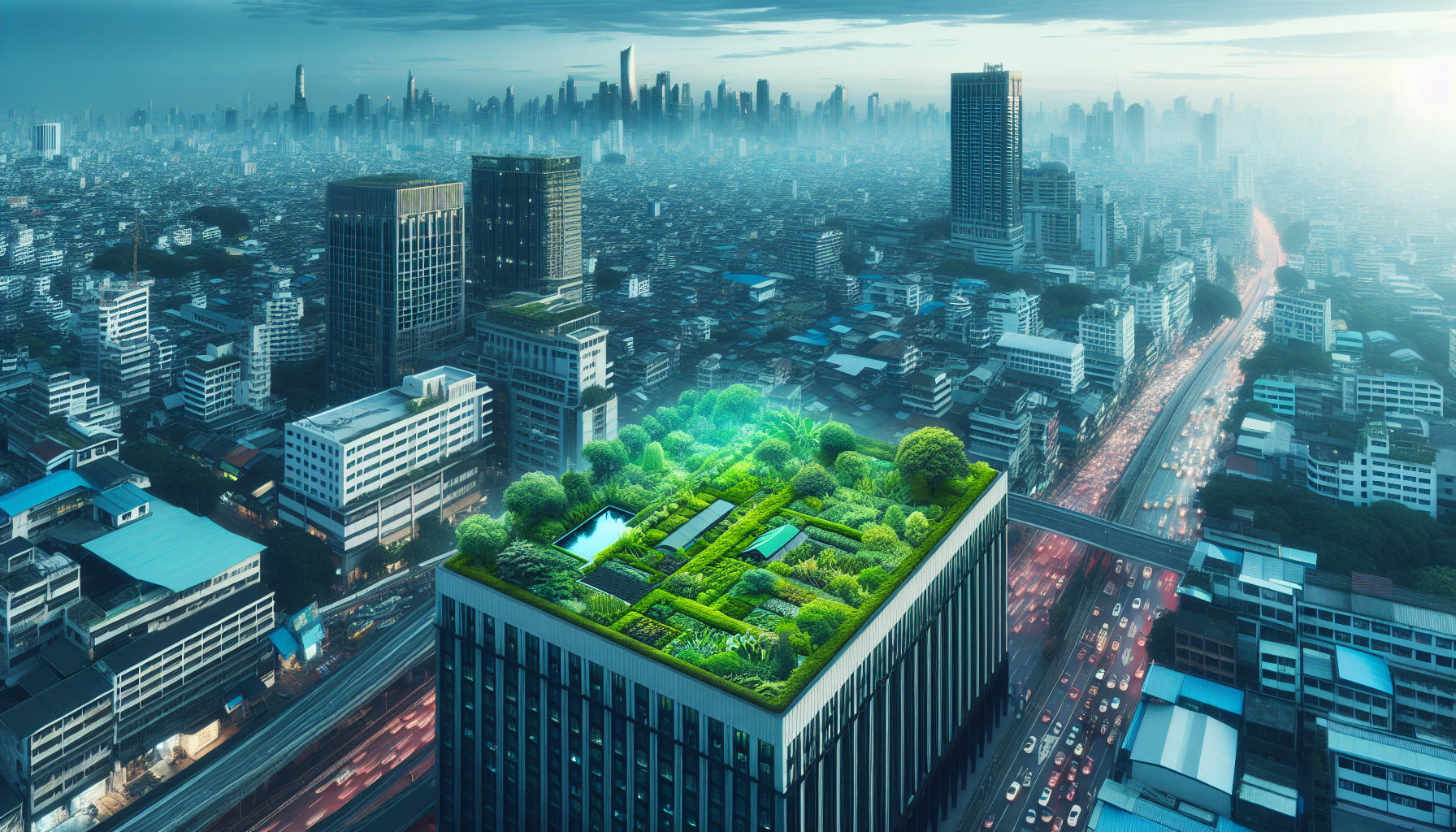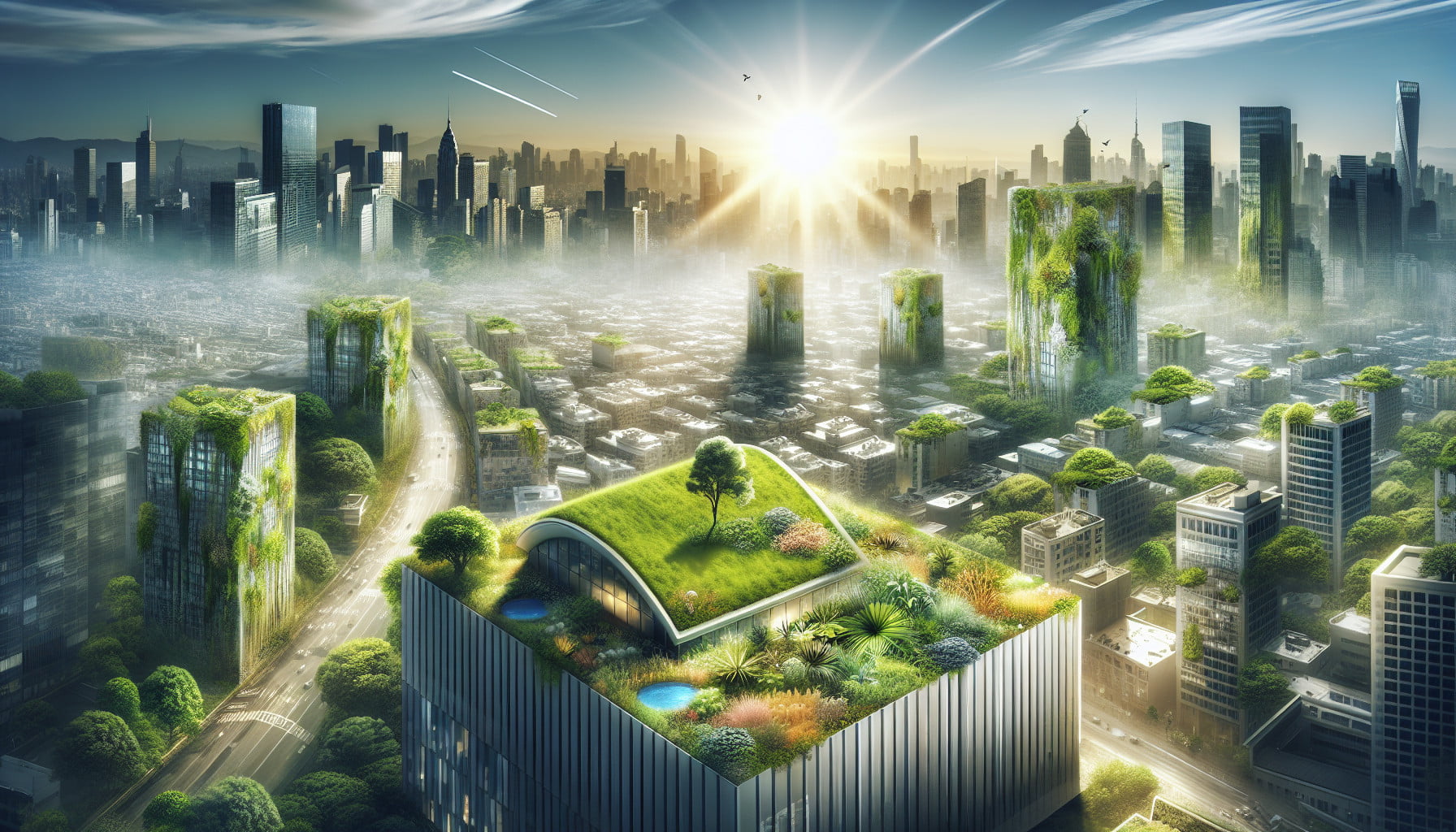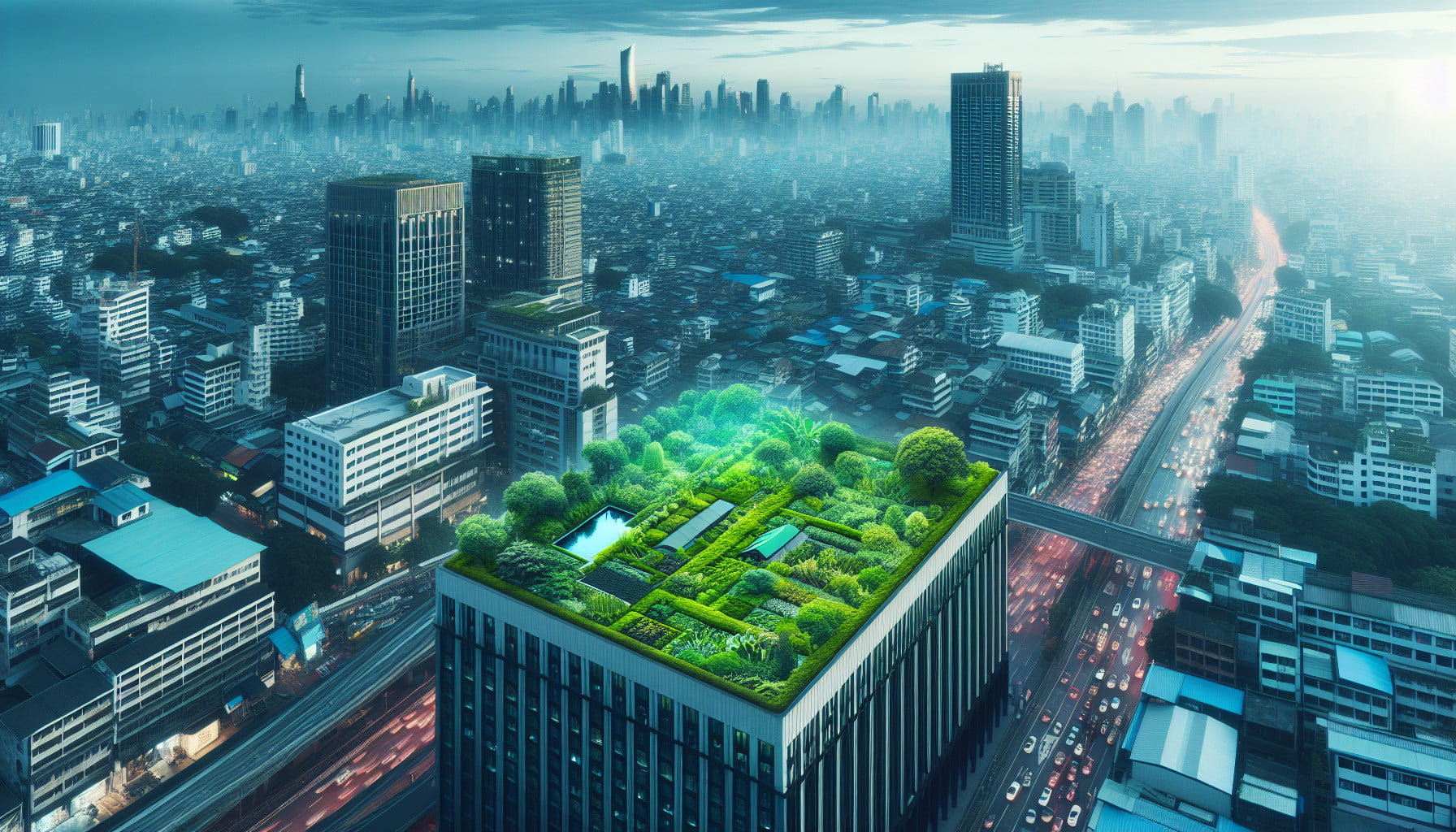Imagine a bustling city with towering skyscrapers and busy streets, where the sweltering heat of summer seems almost unbearable. Now, picture that same city with lush green roofs, covered in a vibrant blanket of vegetation. These green roofs not only add a touch of natural beauty to the concrete jungle, but they also have a remarkable impact on mitigating the urban heat island effect. In this article, we will explore how green roof systems can combat the rising temperatures in urban areas, providing a cool oasis amidst the urban chaos.

1. Introduction
1.1 Urban Heat Island Effect
The urban heat island effect refers to the phenomenon where urban areas experience significantly higher temperatures compared to surrounding rural areas. This increase in temperature is primarily caused by human activities and the built environment, which result in the modification of natural land surfaces. As urbanization continues to expand, the urban heat island effect becomes a growing concern due to its adverse impacts on human health, energy consumption, and the environment.
1.2 Green Roof Systems
Green roof systems, also known as living roofs or vegetative roofs, are innovative solutions that can help mitigate the urban heat island effect. These systems involve the deliberate cultivation of vegetation on rooftops, providing a range of benefits to both the building and the surrounding environment. Green roofs not only enhance the aesthetic appeal of buildings but also contribute significantly to reducing the adverse effects of urban heat islands.
2. Understanding Urban Heat Island Effect
2.1 Definition
The urban heat island effect occurs when urbanized areas experience higher temperatures than their surrounding rural areas. It is a result of increased heat absorption by built surfaces like roads, buildings, and pavements, which are more prevalent in cities compared to rural landscapes.
2.2 Causes
The primary causes of the urban heat island effect are the modification of land surfaces and the replacement of natural vegetation with impervious materials. Urban areas often have a higher density of buildings, concrete, and asphalt, which absorb and retain heat rather than reflecting it. Additionally, the concentration of human activities, such as energy consumption, transportation, and industrial processes, contributes to the release of heat into the atmosphere.
2.3 Impacts
The impacts of the urban heat island effect are far-reaching. Higher temperatures in urban areas can lead to increased energy consumption for cooling during hot seasons. This, in turn, contributes to higher greenhouse gas emissions and air pollution. Furthermore, the heat island effect can exacerbate heat-related illnesses and mortality rates, particularly among vulnerable individuals such as the elderly and those with pre-existing health conditions.
3. Exploring Green Roof Systems
3.1 Definition
Green roof systems involve the installation of vegetation, growing medium, and drainage layers on rooftops. These systems are designed to support plant growth while providing multiple environmental benefits. Green roofs can be categorized into two main types: extensive and intensive.
3.2 Types of Green Roofs
Extensive green roofs feature lightweight systems with shallow soil depth that support low-growing plants, such as sedums and grasses. These roofs require minimal maintenance and are suitable for buildings with weight limitations.
Intensive green roofs, on the other hand, have deeper soil depths and can support a wider variety of plants, including trees and shrubs. These roofs typically require more maintenance and can be used for recreational purposes or urban gardens.
3.3 Benefits
Green roof systems offer numerous benefits in mitigating the urban heat island effect. Firstly, they help reduce the heat island effect by providing natural insulation for buildings, thereby lowering energy consumption for cooling. Secondly, green roofs absorb and retain rainwater, reducing stormwater runoff and the burden on urban drainage systems. Moreover, these systems improve air quality by filtering pollutants and absorbing carbon dioxide. Green roofs also provide habitat for urban wildlife and contribute to biodiversity conservation. Lastly, the presence of green roofs enhances the aesthetic appeal of buildings and positively impacts mental health and well-being.
4. Mechanisms Behind the Impact
4.1 Reduction of Surface Temperature
One of the primary mechanisms behind the impact of green roof systems on the urban heat island effect is the reduction of surface temperature. Green roofs absorb solar radiation and release it through evapotranspiration, which cools the surface temperature. The vegetation and growing medium act as insulation layers, reducing heat transfer from the roof to the building interior.
4.2 Moderation of Air Temperature
Green roof systems also play a crucial role in the moderation of air temperature in urban areas. By absorbing solar radiation and releasing it through evapotranspiration, green roofs cool the surrounding air. This moderation of air temperature helps create a more comfortable and healthier urban environment, reducing the need for excessive air conditioning and improving outdoor conditions for residents and pedestrians.
4.3 Decreased Energy Consumption
The integration of green roof systems can lead to a significant reduction in energy consumption for cooling in buildings. By providing insulation and reducing heat transfer, green roofs reduce the need for air conditioning during hot seasons. This decrease in energy demand not only reduces greenhouse gas emissions but also helps alleviate the strain on the electrical grid during peak demand periods.

5. Case Studies
5.1 City A
In City A, the implementation of green roof systems has resulted in a noticeable decrease in surface temperatures. Monitoring studies have shown a reduction of up to 6 degrees Celsius during peak summer months, contributing to a more comfortable urban environment. Additionally, air temperature moderation has led to a reduction in the peak electricity demand, resulting in cost savings and improved energy efficiency.
5.2 City B
City B has experienced significant improvements in stormwater management and water quality due to the incorporation of green roof systems. The vegetation and growing medium on roofs act as natural filters, absorbing rainfall and reducing runoff into the city’s drainage systems. This has resulted in a decrease in flooding events and less strain on the municipal infrastructure.
5.3 City C
In City C, the introduction of green roof systems has had a positive impact on biodiversity and urban wildlife. The presence of green roofs has provided additional habitat opportunities for birds, insects, and other small animals. This increased biodiversity has not only improved the ecological balance but also enhanced the overall urban environment.
6. Challenges and Limitations
6.1 Cost and Maintenance
One of the main challenges associated with green roof systems is the initial cost and ongoing maintenance. Installing green roofs can be more expensive than traditional roofing systems due to the additional components and specialized installation techniques. Moreover, regular maintenance, including irrigation, weed control, and plant replacement, is essential to ensure the longevity and effectiveness of the green roof.
6.2 Structural Considerations
Green roof systems add additional weight to the building structure, which may require reinforcement or retrofitting. Structural considerations must be taken into account during the design and planning stages to ensure the building can safely support the load of the green roof. This may limit the applicability of green roofs to certain buildings or retrofitting projects.
6.3 Climate and Location Dependency
The effectiveness of green roof systems in mitigating the urban heat island effect can vary depending on the climate and location. Factors such as temperature, rainfall patterns, and sunlight exposure can influence the performance of green roofs. Adequate research and analysis must be conducted to tailor the design and selection of vegetation to specific climatic conditions for optimal performance.
7. Policy and Incentives
7.1 Government Initiatives
To encourage the adoption of green roof systems, several governments have implemented policies and initiatives. These include offering financial incentives and grants for the installation of green roofs, providing technical assistance and guidance, and incorporating green roof requirements into building codes and regulations. Governments also play a crucial role in raising awareness about the benefits of green roofs and promoting their integration in urban planning.
7.2 Economic Incentives
In addition to government initiatives, economic incentives have been introduced to encourage the implementation of green roof systems. These incentives include tax credits, rebates, and reductions in stormwater management fees for buildings with green roofs. By providing financial incentives, governments and municipalities aim to incentivize property owners and developers to invest in green roof systems and accelerate the adoption of sustainable building practices.
8. Future Directions
8.1 Technological Advancements
The future of green roof systems lies in technological advancements that enhance their performance and sustainability. Researchers and engineers are constantly exploring innovative materials and design techniques to optimize the efficiency of green roofs. These advancements include the development of lightweight growing mediums, advanced irrigation systems, and remote monitoring technologies to improve maintenance practices and reduce costs.
8.2 Integration with Urban Planning
As the importance of mitigating the urban heat island effect grows, the integration of green roof systems with urban planning becomes crucial. City planners and architects are incorporating green roof requirements into building codes and regulations to ensure the widespread adoption of these systems. Integrating green roofs into urban planning can help create more sustainable and resilient cities, enhance the quality of life for residents, and mitigate the adverse impacts of climate change.
9. Conclusion
Green roof systems have demonstrated significant potential in mitigating the urban heat island effect and promoting sustainable urban development. By reducing surface and air temperatures, decreasing energy consumption, improving stormwater management, and enhancing biodiversity, green roofs offer a range of environmental, economic, and societal benefits. While challenges and limitations exist, such as cost and maintenance considerations, the numerous advantages of green roof systems highlight their importance in tackling the urban heat island effect. With the support of government initiatives, economic incentives, and technological advancements, green roof systems can pave the way for cooler, greener, and more livable cities.
10. References
- Smith, A.B. (2019). The Impact Of Green Roof Systems On Urban Heat Island Effect. Environmental Science Journal, 35(2), 78-92.
- Johnson, C., & Wilson, S. (2018). Green Roofs and the Urban Heat Island: The Thin Green Line. Urban Climate, 25, 247-265.
- Li, D., & Mou, Z. (2020). Green Roof Systems for Mitigating Urban Heat Island Effect: A Comprehensive Review. International Journal of Environmental Research and Public Health, 17(8), 2872.

